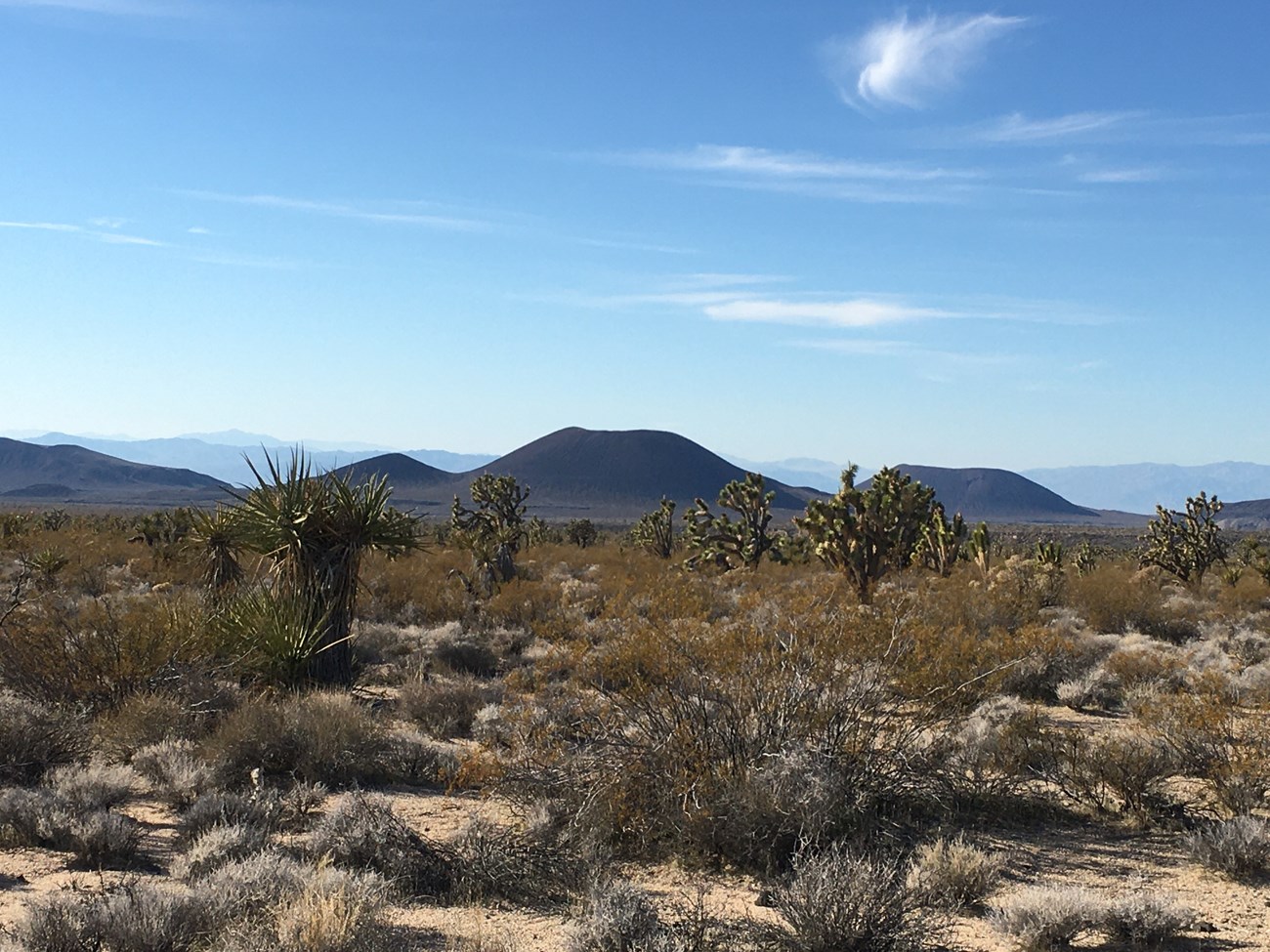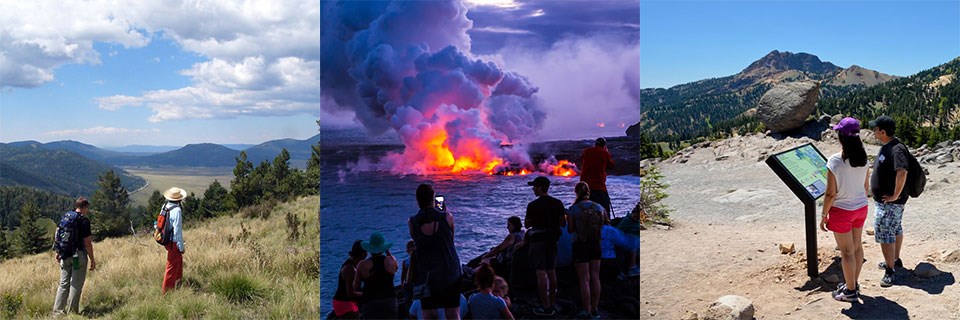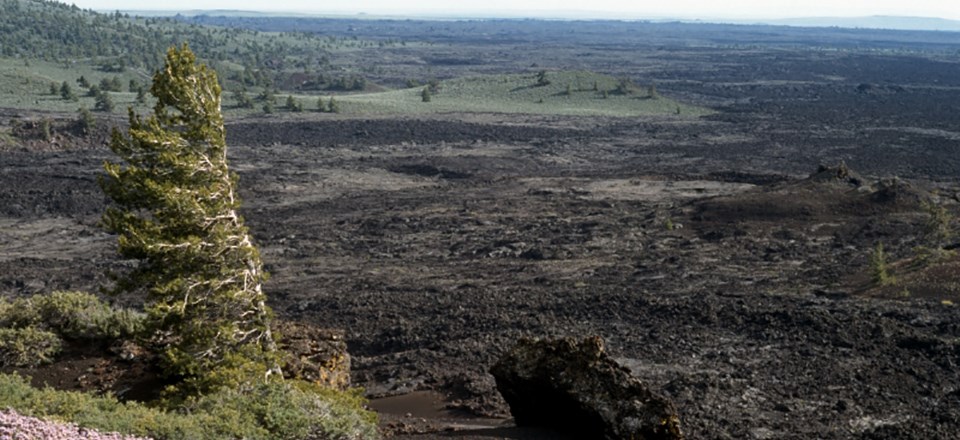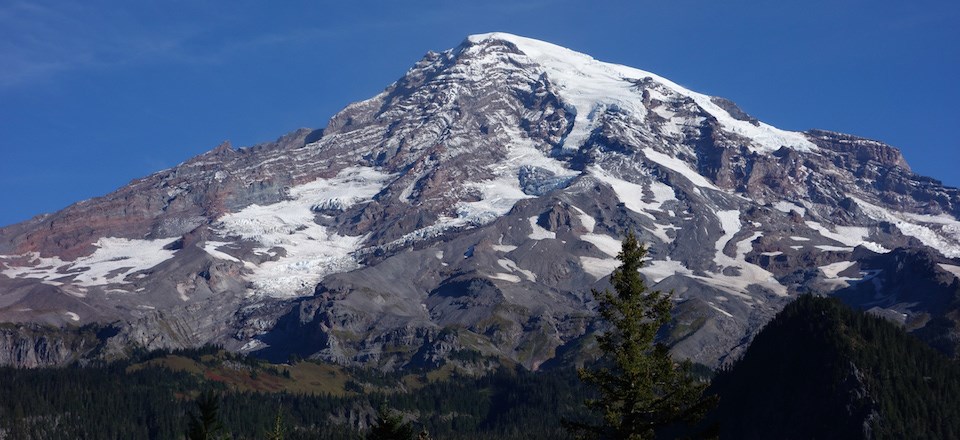
NPS photo.
Introduction
Volcanoes both build and destroy landscapes. Eruptions of lava, ash, volcanic bombs, blocks, and cinders form new land on oceanic islands, and build towering and inspiring snow-covered peaks. Volcanic eruptions are also destructive as they can blow apart those very same mountains. They also can cover vast areas of fertile land with inhospitable lava flows and/or ash deposits. Further, volcanoes present geohazards to the public, both during eruptions and during periods of quiescence.
In turn, volcanoes are also impacted by the weathering and erosion processes that shape all land surfaces on Earth. Through time, the appearance of any volcano may change from a pristine cone and shield as depicted in textbooks to worn mountains and landscapes that no longer resemble their original shape (geomorphology) except for the telltale signs of certain volcanic features and the presence of volcanic rocks.
As they experience the ravages of time, volcanoes can become dissected by gulleys and valleys, experience landslides and slope failures, be carved by glaciers, and/or become nearly-completely worn away. Sometimes all that remains of a volcano is the rock that solidified in the conduit leading to its vent that becomes a free-standing volcanic neck. See, Erosional Volcanic Landforms
The appearance of any given volcano depends on a variety of factors including:
-
Composition and viscosity of the magma
-
Gas content of the magma
Diversity of NPS Volcanic Landforms

NPS photos.
The result of these variables is that a great diversity of volcanic landforms exists. National parks contain nearly the full-range of terrestrial volcanic landforms from active volcanoes, young cinder cones, gigantic calderas, and areas covered by vast lava flows to ancient volcanoes that are deeply-eroded and old lava flows that no longer retain their surface features.
Many of the most beautiful and awe-inspiring volcanoes in North America are in national parks. These parks tell a wide spectrum of volcanic stories:
-
Hawaii Volcanoes National Park contains Kilauea, the most active volcano in the United States.
-
Yellowstone National Park is the site of some of the largest volcanic eruptions known to have ever occurred.
-
Crater Lake National Park contains a caldera that contains the deepest lake in the United States.
-
Sunset Crater Volcano National Monument preserves Sunset Crater, the youngest volcano in the San Francisco volcanic field. Sunset Crater is an exceptionally large cinder which experienced an unusually explosive eruption.
-
El Malpais National Monument contains extensive basaltic lava flows which are studied by geologists to better understand volcanism on Mars and other planets.
-
Katmai National Park contains the Valley of Ten Thousands Smokes, formed by the 1912 eruption of Novarupta which was the largest eruption in the 20th century.
What is a Volcano?


Left image
Fissure Volcanoes at Craters of the Moon.
Credit: NPS photo.
Right image
A Composite Volcano (Stratovolcanoe) such as Mount Rainier.
Credit: NPS photo.
A volcano can be one of two things, or both:
-
A vent where molten rock material emerges from the Earth’s interior
-
The edifice (mountain or cone) that forms around that vent or a series of vents during eruption(s).
Vents are places where lava (molten rock material) is emitted at the Earth’s surface. They can be circular, elongate, or linear, and may range in size from a few tens of feet wide to fissures that are tens of miles long.
Many (if not most) volcanic mountains have more than one vent at the surface. These vents are generally connected to a shared underground plumbing system tapping a magma chamber or chambers beneath the volcano. Large volcanoes in particular may have eruptions at flank or satellite vents in addition ones at the central vent at the mountain’s summit.
Eruptions may be either effusive (non-violent) or explosive. The style and intensity of an eruption may change through time. Non-violent eruptions emit lava flows or domes, whereas explosive ones eject volcanic ash and other rock and lava fragments (pyrcolasts) into the atmosphere in eruption columns and in pyroclastic flows that cascade down the volcano’s slopes.
Volcanic mountains, domes, and cones of varying size and shapes are found around most vents, except where highly-fluid lavas are erupted from linear or fissure vents. These lavas instead flow out and away from vents to form vast lava fields. Even in these cases, small accumulations of lava may pile up along the trace of the vent, but these may fall far short of forming hills of any stature.
Learn More
[Site Under Development]
-
Volcanic Landscapes
Volcano types in Units of the National Park System
Click here to see which national park areas contain cinder cones, shield volcanoes, and other types of volcanoes.
Featured Parks
-
Crater Lake National Park (CRLA), Oregon—[CRLA Geodiversity Atlas] [CRLA Park Home] [CRLA npshistory.com]
-
El Malpais National Monument (ELMA), New Mexico—[ELMA Geodiversity Atlas] [ELMA Park Home] [ELMA npshistory.com]
-
Hawaii Volcanoes National Park (HAVO), Hawaii—[HAVO Geodiversity Atlas] [HAVO Park Home] [HAVO npshistory.com]
-
Katmai National Park (KATM), Alaska—[KATM Geodiversity Atlas] [KATM Park Home] [KATM npshistory.com]
-
Sunset Crater Volcano National Monument (SUCR), Arizona—[SUCR Geodiversity Atlas] [SUCR Park Home] [SUCR npshistory.com]
-
Yellowstone National Park (YELL), Idaho, Montana, and Wyoming—[YELL Geodiversity Atlas] [YELL Park Home] [YELL npshistory.com]
Last updated: April 17, 2023
